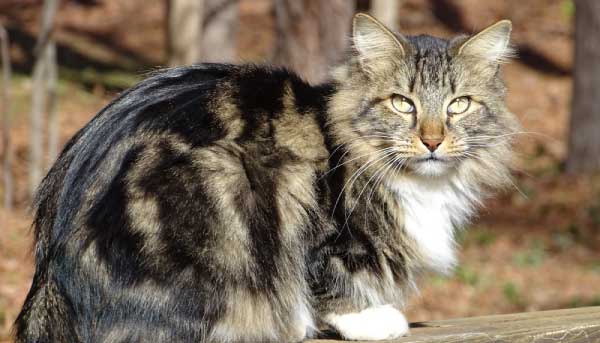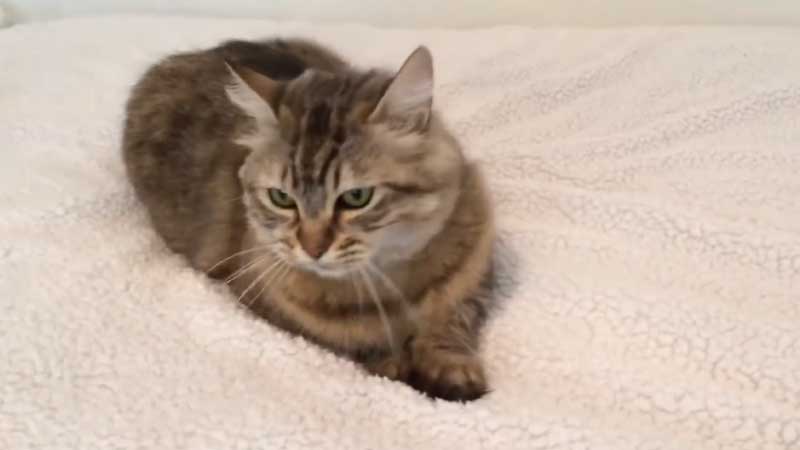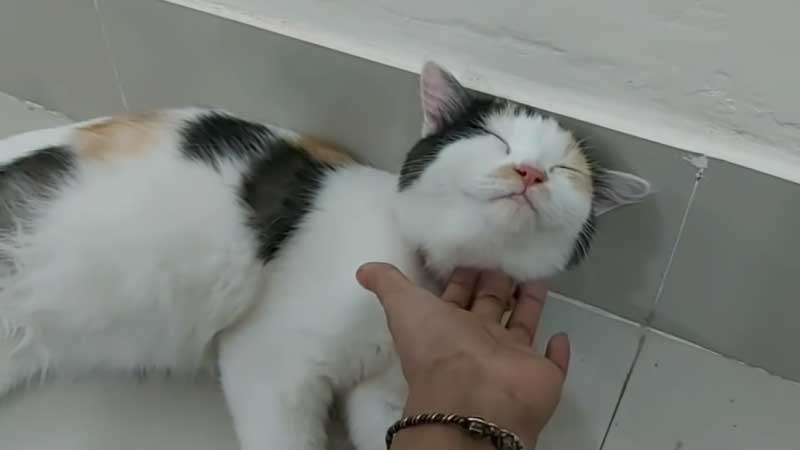The American Bobtail Cat Breed is a medium to large, muscular cat, known for its unique bobbed tail, versatile coat colors, and patterns, and a playful, adaptable personality. Originating in the United States, this breed is perfect for families, individuals, and frequent travelers, thanks to its social and affectionate nature.
In the following sections, we’ll dive into every aspect of the American Bobtail Cat Breed, from their interesting origins and standout physical characteristics to their personality, health, and care needs. Stay with us as we explore why the American Bobtail might just be the purr-fect addition to your life!
American Bobtail Cat Breed Information

| Characteristic | Detail |
|---|---|
| Name | American Bobtail |
| Other Name | N/A |
| Origin | United States |
| Size | Medium to large |
| Height | Not commonly specified |
| Weight | 7 to 16 pounds |
| Lifespan | Up to 15 years |
| Colors | Black, blue, brindle, brown, calico, chocolate, cinnamon, fawn, lilac, pied, red-and-cream, peach or orange tabby, tortoiseshell |
| Coat Length | Short to long, shaggy coat |
| Coat Patterns | Any, with a preference for “wild” markings |
| Temperament | Playful, social, adaptable |
| Suitable for | Families, individuals, travelers |
American Bobtail Cat Breed Characteristics

The American Bobtail cat is not just another pretty face in the feline world. This breed is known for its robust characteristics, making it a perfect fit for various households and lifestyles. From their remarkable adaptability to their affectionate nature, American Bobtails exhibit a blend of qualities that make them more than just pets – they are pets for life.
| Characteristic | Rating | Description |
|---|---|---|
| Adaptability | High | Adjusts easily to different living environments and lifestyles, making it an excellent companion for most households. |
| Intelligence | Medium to High | Smart and curious, these cats enjoy interactive play and can be trained to perform tricks. |
| Playfulness | High | Loves to play and engage in activities, making them entertaining and lively pets. |
| Affection Level | High | Extremely loving and enjoys spending time with their human companions, perfect for those seeking a cuddly pet. |
| Energy Level | Medium to High | Active without being overly hyper, suitable for both active and moderately active owners. |
| Dog Friendly | High | Gets along well with dogs, making them a great choice for multi-pet households. |
| Kid-Friendly | High | Patient and tolerant, making them a safe and playful companion for children. |
| Stranger Friendly | Medium | Friendly but may be cautious around new people, warming up as they get familiar. |
| Exercise Needs | Medium | Requires regular play and activity to stay healthy and engaged. |
| Health Issues | Medium | Generally healthy, but like all breeds, they have a few health concerns that will be detailed later. |
| Shedding | Medium | Sheds moderately, requiring regular grooming to keep their coat in good condition. |
| Grooming | Low to Medium | Easy to groom, with short to medium coat lengths that do not require extensive care. |
Overview of the American Bobtail Cat Breed
The American Bobtail is a breed that captures attention with its distinctive appearance and adorable personality. Physically, this breed ranges from medium to large size, with males typically being larger than females. They usually weigh between 7 to 16 pounds, showcasing a muscular and athletic build that belies their gentle nature.
One of the most striking features of the American Bobtail is its coat, which can vary significantly in length and texture. The coat can be either short or long, but it is often shaggy rather than dense or fluffy. This breed boasts a wide array of colors and patterns, with no two American Bobtails looking exactly alike.
The most common colors include black, blue, brindle, brown, calico, chocolate, cinnamon, fawn, lilac, pied, red-and-cream, peach or orange tabby, and tortoiseshell. The coat patterns are equally diverse, with a notable preference for “wild” markings that give them a striking, almost exotic appearance.
The breed’s namesake feature, its tail, is another unique aspect. The tail of an American Bobtail is naturally short, bobbed, and may vary in shape – straight, kinked, or bumped. This distinctive tail is typically about one-third to one-half the length of a normal cat’s tail, giving them a unique silhouette.
Pros
Cons
Personality of the American Bobtail Breed

The American Bobtail is much more than just a pretty face with a unique tail; it possesses a personality that is as rich and varied as its appearance. This breed is known for its remarkable social behavior, playfulness, and ability to interact harmoniously with humans and other pets, making it a delightful companion.
Social Behavior
American Bobtails are exceptionally sociable cats. They thrive on interaction with their human families and often form deep, affectionate bonds. Unlike some feline breeds that may prefer solitude, American Bobtails actively seek out company and enjoy being involved in family activities. They are known to follow their owners from room to room, displaying a dog-like loyalty and companionship. This breed is also known for its communicative nature, often using soft chirps and trills to express themselves, making their presence in the home both felt and heard.
Playfulness
Playfulness is a standout trait in American Bobtails. They retain a kitten-like love of play well into adulthood, engaging in games and interactive play with enthusiasm. Their playful nature is not just entertaining but also reflects their intelligent and curious minds. They can be taught to play fetch and enjoy puzzle toys that challenge their intellect. This zest for play makes them excellent pets for families with children, as they are often patient and gentle with kids, enjoying the mutual interaction and stimulation.
Interaction with Humans
American Bobtails are known for their affectionate nature towards humans. They are not overly demanding of attention but certainly enjoy and appreciate it. They have a calm and patient demeanor, which makes them excellent companions for individuals of all ages, including the elderly. Their adaptability also means they are quite comfortable in various living situations, whether it’s a bustling family home or a quiet apartment.
Interaction with Other Pets
This breed shows a remarkable ability to get along with other pets, including dogs. They are often unfazed by the presence of other animals in the household and can integrate well into multi-pet homes. Their friendly and non-aggressive nature allows them to form bonds with other cats and even dogs, making them an ideal choice for a household looking for a harmonious pet integration.
Common Health Problems in the American Bobtail Cat Breed
The American Bobtail is generally a healthy breed, but like all breeds, they can be predisposed to certain health issues. Being aware of these potential health concerns is crucial for prospective and current owners to ensure the best care for their feline companions. Here are 3-4 health issues commonly associated with the American Bobtail:
Spinal Issues
Given their unique tail, American Bobtails can sometimes be prone to spinal problems, although this is less common than in some other bobtailed breeds. These issues can range from mild to severe and may affect the cat’s mobility. Regular veterinary check-ups can help identify any spinal abnormalities early.
Hip Dysplasia
This is a genetic condition where the hip joint does not fit together perfectly, which can lead to arthritis or lameness. It’s more commonly associated with dogs but can occur in cats, including the American Bobtail. Maintaining a healthy weight and regular exercise can help manage this condition.
Heart Conditions
Some American Bobtails may be susceptible to heart issues, such as hypertrophic cardiomyopathy (HCM), a condition where the heart muscle thickens. Early detection through regular veterinary screenings is key to managing heart conditions effectively.
Dental Problems
Like many cat breeds, American Bobtails can experience dental issues, including periodontal disease. Regular dental check-ups and cleanings, along with good oral hygiene practices at home, are essential for maintaining their dental health.
How to Care for the American Bobtail Breed

Caring for an American Bobtail involves a combination of proper diet, regular exercise, grooming, and general care to ensure they lead a healthy and happy life. Here are some guidelines:
Diet
- Quality Food: Feed your American Bobtail high-quality cat food that meets their nutritional needs. The diet should be appropriate for their age, size, and activity level. Kittens, adults, and senior cats have different dietary requirements.
- Controlled Portions: Monitor food portions to prevent obesity, a common problem in domestic cats. Obesity can lead to various health issues, including diabetes and joint problems.
- Fresh Water: Always provide access to fresh, clean water. Hydration is crucial for maintaining good health.
Exercise
- Active Playtime: American Bobtails are playful and energetic. Provide daily play sessions to keep them active and mentally stimulated. Interactive toys, puzzle feeders, and games like fetch can be beneficial.
- Safe Outdoor Access: If possible, provide safe, supervised outdoor access. This could be a securely fenced yard or a leash walk. Ensure their environment is safe from traffic and predators.
Grooming
- Coat Care: Brush their coat regularly, especially for long-haired varieties, to prevent matting and reduce shedding. Short-haired Bobtails require less frequent grooming.
- Dental Hygiene: Regular dental care is essential. Brush their teeth frequently with a vet-approved toothpaste and schedule regular dental check-ups.
- Nail Trimming and Ear Cleaning: Trim their nails as needed and check their ears regularly for signs of dirt, wax buildup, or infection.
General Care
- Regular Vet Visits: Schedule regular veterinary check-ups to monitor their health and catch any potential issues early.
- Vaccinations and Parasite Control: Keep up with vaccinations and regularly check for and treat parasites like fleas, ticks, and worms.
- Spaying/Neutering: Consider spaying or neutering your cat to prevent unwanted litters and reduce the risk of certain health problems.
- Environment: Provide a safe and stimulating environment with access to window perches, scratching posts, and safe hiding places.
Remember, each cat is unique, so adapt these guidelines to your specific pet’s needs and consult your veterinarian for personalized advice.
Frequently Asked Questions
Are American Bobtails good with children and other pets?
Yes, American Bobtails are known for their friendly and sociable nature, making them excellent companions for children and other pets, including dogs. They are generally patient and tolerant, but as with any animal, interactions should be supervised, especially with younger children.
How active are American Bobtails?
American Bobtails have a moderate to high level of activity. They enjoy play and are often engaged in activities around the house. They are not excessively hyper but do appreciate interactive playtime and mental stimulation through toys and games.
Do American Bobtails require a lot of grooming?
Their grooming needs depend on the coat length. Short-haired Bobtails require minimal grooming, while long-haired ones need more frequent brushing to prevent matting. Regardless of coat length, routine grooming is important for overall health.
How long do American Bobtails typically live?
With proper care, American Bobtails can live up to 15 years or more. Regular veterinary care, a balanced diet, and a healthy lifestyle contribute to their longevity.
Can American Bobtails adapt well to apartment living?
Yes, American Bobtails are adaptable to various living situations, including apartments. They are relatively easygoing and can thrive in smaller spaces as long as they have enough mental and physical stimulation.
Are American Bobtails prone to any specific health issues?
While generally healthy, they can be prone to certain conditions like spinal problems, hip dysplasia, heart issues, and dental problems. Regular health check-ups and a healthy lifestyle can help mitigate these risks.
Is the American Bobtail vocal?
American Bobtails are moderately vocal. They are not as talkative as some other breeds but do communicate with their owners through chirps, trills, and meows, especially when seeking attention or during playtime.
Final Verdict
Overall, if you’re looking for a loyal, affectionate, and somewhat dog-like companion in a cat, the American Bobtail cat breed is an excellent choice. Their striking looks, combined with their loving and playful nature, make them not just pets but beloved family members. This breed, with its distinctive characteristics and charming personality, is sure to bring joy and companionship to any home.
Regular veterinary check-ups, a nutritious diet, and adequate exercise are crucial in maintaining their health and well-being.




